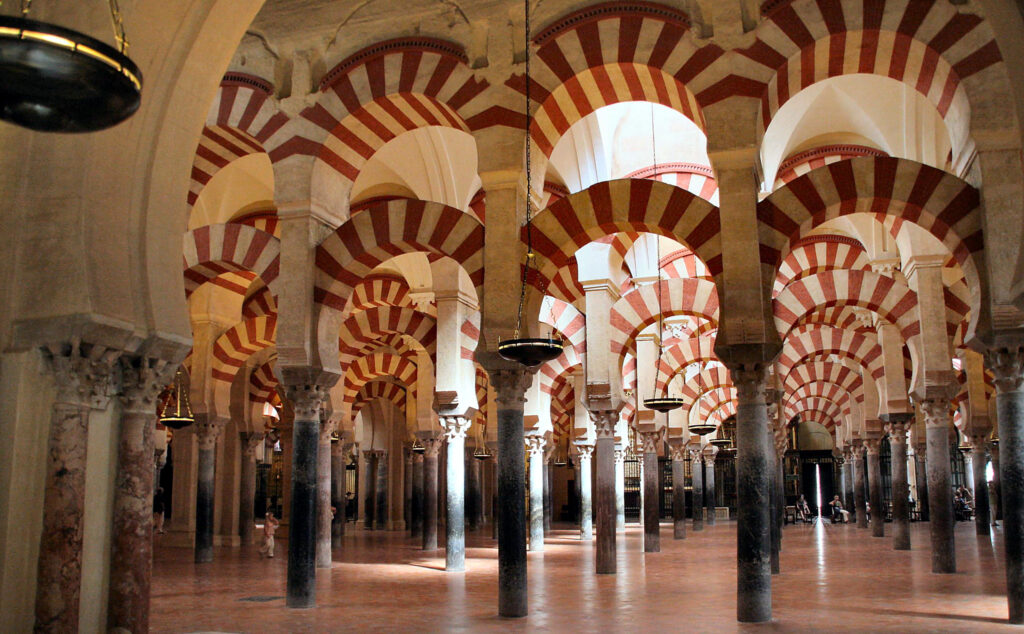
The cathedral-mosque of Córdoba.
I think of the Greek god Pan as an old goat, horny and hooved. Built like a faun or satyr (neither of which recommend him for polite society), he was deliberately rustic, at home in the wild, the kind of guy you expect to wear a leather jacket, use vulgar language, and perform surprisingly well in bed.
You do not expect to find him entombed in a Byzantine church.
Granted, the homage to Pan was an altar that had been sealed inside a wall. Only the lucky archaeologists made the connection. The altar’s inscription dedicates this bit of basalt to the god Pan Heliopolitanus—which is confusing, because the ancient city of Heliopolis is usually used to tag Zeus, the all-powerful polygamist at the head of Mount Olympus. Some say Pan was Zeus’s son, though, and in any event, the gentleman who engraved this tribute, “using his own personal money in fulfillment of a vow he made,” was not entirely adept. His letters shrink and sprawl to the edges over as he ran out of room in the stone.
The Byzantine church was built atop an open-air temple to Pan around 400 CE. Why wrap a wall around the basalt pillar? Maybe to raise a middle finger to any remaining devotees of the goat god? Or, who knows, maybe the altar helped strengthen the wall, just as Mithraism laid a foundation for Christianity. A December 25 birth festival, a water miracle, a sacrifice, a promise of salvation, a symbolic communal meal, a sign of the cross…. It was Zoroaster who introduced monotheism itself, elaborating concepts of heaven and hell, Judgment Day, angels, and demons. We forget—or were not encouraged to know.
Quite a few Mithraic sites are buried beneath Christian churches. “If the growth of Christianity had been arrested by some mortal malady, the world would have been Mithraic,” Ernest Renan wrote in 1882. Instead, Christianity grew like honeysuckle, obscuring its predecessors.
An early eleventh-century tower at St. Peter-at-Gowts includes a stone panel blurred by centuries of wind and rain. The figure seems to have the long face and wild mane of a lion and could be a Mithraic god, Arimanius, who held the keys to heaven. In other words, the joke may be on the medieval Christian builders, who unwittingly reused a Mithraic relief because they thought it represented St. Peter and his keys.
Does every religion insist on covering or supplanting its predecessors? The Dome of the Rock, the oldest Islamic monument still intact, was built at the site of Solomon’s Temple. Coricancha, the golden temple at the center of the Inca empire, was destroyed by the Spanish conquistadores, and its stonework was used as the foundation for the Santa Domingo Convent. The Cathedral of Our Lady of the Assumption in Córdoba was once an Islamic mosque—and before that, a Catholic basilica.
I think of this layering and hiding when I read about the Gospel of Judas, fragmentary texts first published in 2006. In these pages, Judas is not a traitor. He acted at Jesus’s bidding, not on a bribe, and he did not commit suicide in remorse; he was stoned to death by other disciples, whose understanding of Jesus’s life and death was more shallow than his.
Scholars think the text—which is wry and funny and bold, consisting mainly of conversations between Judas and Jesus—was composed by Gnostic Christians in the second century. They were horrified by the bishops who were urging martyrdom, which seemed no better than human sacrifice. Why would a loving God desire the bloody, painful death of his son or their followers? These Christians saw God not as a bearded old man but as a “luminous cloud of light,” existing in a realm where nothing perishes. The other disciples took Jesus too literally, Judas tells us, when they assumed there would be a bodily resurrection.
What if the Gospel of Judas had joined the others, hand-copied and reprinted and preached for centuries? Theologians have relegated it, along with other fragmentary gospels that failed to make the cut, to the eccentric fringe. But could Christianity have evolved in a different spirit, with scholars arguing over these texts as Talmud scholars argue theirs, rather than excluding what seemed eccentric? I can imagine more emphasis on how to live, think, and question; less emphasis on dogma and evangelism and canon.
Nothing is as simple, as pure, or as absolute as we want it to be. And there is intrigue and rich meaning in all these layers we cover over. Why not build churches alongside temples instead of on top of them? Why not leave the Pan altar in a courtyard, surrounded by trees and wildflowers, as a relic of an earlier time? Ah, but we always want to pretend that the new way of thinking stands alone and apart, shining and perfect.
Literary critic Harold Bloom wrote about “the anxiety of influence”—poets internalizing what they read and then agonizing over the possibility that their own work is merely derivative.
So?
“There is nothing new under the sun.” A reminder that did make the final cut.
Read more by Jeannette Cooperman here.
